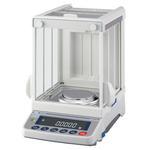Analytical and Precision Balances
|
|
|
| Lab Balances by Readability |
|
|
| Manufacturers |
|
|
|
|
Pharmacy Balances |
 |
|
Pharmacy balances are precision instruments used in pharmacies to measure small amounts of substances, typically for compounding medications or quality control. These balances are critical for ensuring the accurate dosing of medications, which is essential for patient safety and therapeutic efficacy.
|
Find Milligram Balances by Readability
| Pharmacy Balances |
| Series |
AND GF-P |
RADWAG PS-R2 |
RADWAG AS-R2 |
Ohaus SJX |
| Price From |

$972.80
|

$1,040.40
|

$2,203.51
|

$242.00
|
| Capacity X Readability |
210g x 1 mg
310g x 1 mg |
360 g x 1 mg
1000 g x 1 mg
2100 g x 0.01 g
4500 g x 0.01 g |
60 g x 0.01 mg
82 g x 0.01 mg
220 g x 0.1 mg
310 g x 0.1 mg
520 g x 0.1 mg |
64 g x 1 mg
1500 x 0.01 g |
| Legal For Trade |
NTEP Class II
210g x 10 mg
310g x 10 mg |
NTEP Class II
360 g x 1 mg
1000 g x 1 mg
2100 g x 0.01 g
4500 g x 0.01 g |
NTEP Class I
60 g x 1 mg
82 g x 1 mg
220 g x 1 mg
310 g x 1 mg
520 g x 1 mg |
NTEP Class II
64 x 0.01 g
1500 x 0.1 g |
| Type |
Digital |
Digital |
Digital |
Digital |
|
more info |
more info |
more info |
more info |
| Series |
AND Apollo Series |
Ohaus EX Explorer |
Ohaus Adventurer AX |
| Price From |

$2,077.55
|

$5,596.40
|

$3,919.35
|
| Capacity X Readability |
122 x 0.0001 g
220 x 0.0001 g
320 x 0.0001 g |
220g x 1 mg
320g x 1 mg
1100g x 0.01g |
220 g x 0.1 mg |
| Legal For Trade |
NTEP Class I
122 x 0.001 g
220 x 0.001 g
320 x 0.001 g |
NTEP Class I
220g x 1 mg
320g x 1 mg
1100g x 0.01g |
NTEP Class I
220 g x 1 mg |
| Type |
Digital |
Digital |
Digital |
|
more info |
more info |
more info |
| Series |
Mettler Toledo XPR |
Sartorius Entris-II |
Rice Lake TP-Series |
| Price From |

$12,169.00
|

$2,077.50
|

$1,309.50
|
| Capacity X Readability |
210 g x 0.1 mg
410 g x 0.1 mg
510 g x 0.1 mg
510 g x 1 mg |
60 g x 0.1 mg
120 g x 0.1 mg
220 g x 0.1 mg |
6200 x 0.01 g |
| Legal For Trade |
NTEP
210 g x 0.1 mg
410 g x 0.1 mg
510 g x 0.1 mg
510 g x 1 mg |
NTEP CLASS I CC# 22-017
120 g x 1 mg
220 g x 1 mg |
NTEP Class II
6200 x 0.01 g |
| Type |
Digital |
Digital |
Digital |
|
more info |
more info |
more info |
Here are examples of reliable pharmacy balances across different types:
1. Analytical Balances
Mettler Toledo XPR Analytical Balance
Precision: Readability up to 0.01 mg.
Features: Touchscreen display, integrated quality assurance, and a SmartPan for enhanced weighing stability.
Ideal For: Measuring active pharmaceutical ingredients (APIs) in extremely small quantities.
Sartorius Entris II Analytical Balance
Precision: Readability up to 0.1 mg.
Features: Easy calibration, user-friendly interface, and compact design.
Ideal For: Small pharmacy labs or compounding units.
2. Precision Balances
Ohaus Explorer Precision Balance
Precision: Readability from 1 mg to 1 g.
Features: Advanced touchscreen, modular display, and robust construction.
Ideal For: General compounding and ingredient weighing.
Adam Equipment Highland Precision Balance
Precision: Readability of 0.001 g to 0.1 g.
Features: ShockProtect™ to prevent overload damage and a USB interface for data logging.
Ideal For: Everyday pharmacy tasks with moderate precision needs.
3. Top-Loading Balances
A&D FX-i Series Top-Loading Balance
Precision: Readability up to 1 mg.
Features: Compact design, internal calibration, and a fast response time.
Ideal For: Routine pharmaceutical weighing with quick results.
Mettler Toledo MS-TS Precision Balance
Precision: Readability of 1 mg to 10 mg.
Features: Large touchscreen, sturdy design, and advanced safety features.
Ideal For: Handling slightly larger quantities of substances.
4. Microbalances
Sartorius Cubis II Microbalance
Precision: Readability up to 1 µg (microgram).
Features: Modular design, integrated applications for enhanced accuracy, and user-specific configuration.
Ideal For: Ultra-precise pharmaceutical research or production.
Mettler Toledo XP Microbalance
Precision: Readability up to 0.001 mg.
Features: SmartGrid technology for efficient weighing and minimal interference.
Ideal For: High-precision tasks requiring extreme accuracy.
|
Types of Pharmacy Balances
- Analytical Balances - Extremely precise, with readability typically in the range of 0.1 mg to 0.01 mg. Used for measuring very small quantities of active pharmaceutical ingredients (APIs).
- Precision Balances - Less precise than analytical balances, with readability ranging from 1 mg to 1 g. Suitable for routine tasks like weighing excipients.
- Microbalances - Ultra-precise instruments with readability up to 1 µg (microgram). Used for highly specialized applications.
- Top-Loading Balances - Offer moderate precision and are user-friendly. Commonly used for general compounding tasks.
Features of Modern Pharmacy Balances
- Digital Readouts: Provide easy-to-read, precise measurements.
- Tare Function: Allows users to exclude the weight of containers.
- Calibration Options: Internal or external calibration to maintain accuracy.
- Draft Shields: Prevent environmental factors like air currents from affecting measurements.
- Connectivity: USB or wireless options for data transfer and integration with pharmacy systems.
Applications in Pharmacy
- Compounding: Weighing active ingredients and excipients to prepare custom medications.
- Quality Control: Ensuring the consistency and accuracy of pharmaceutical preparations.
- Inventory Management: Measuring bulk substances for inventory control.
|

